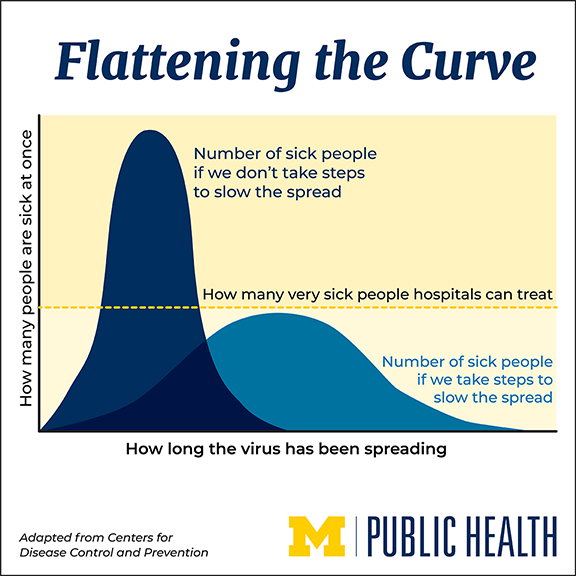3 Things to Know about Managing the Spread of Coronavirus

Interview with Joseph Eisenberg
Professor and Chair of Epidemiology
As people across the US and around the world adjust to living in isolation, working remotely, and limiting in-person outings, it’s important to take the spread of coronavirus seriously in this unprecedented situation.
We talked with Joseph Eisenberg, professor and chair of Epidemiology at the University of Michigan School of Public Health, to learn more about coronavirus; COVID-19, the disease caused by coronavirus; and the current steps being taken to curb the outbreak.
COVID-19 is not the same as the flu.
COVID-19 is a respiratory disease that is transmitted very much like seasonal influenza, but there are important differences, Eisenberg says. For example, it seems to be more transmissible and deadlier than the seasonal flu.
“I think we take the flu season for granted,” Eisenberg says. “It happens every year. And the flu season does kill tens of thousands of people a year in the US alone. But it’s a known entity. And we’re never quite as fearful of the known as we are of the unknown. I think in some ways that plays to our advantage because, with coronavirus, people will be more vigilant and wash their hands, avoid crowds and be more careful if they’re sick.”
Social distancing and other prevention measures will save lives.
“We need to take this seriously,” Eisenberg says. “A lot of the social distancing steps being taken—such as cancelling big events, switching universities and schools to online teaching, closing bars and restaurants, and encouraging individuals to stay 3 to 6 feet apart—are vital to controlling the disease and ultimately saving lives in this situation.”
Each of these social distancing measures limit contact with other people, which helps to minimize exposure and reduce transmission of coronavirus. Each of these measures also have costs to society and the economy. In the long run, therefore, we will have to plan on relaxing some measures while maintaining others.
 Coronavirus may continue to spread and infect people, but precautions like social
distancing will spread out the number of infections over months rather than weeks.
The rising curve of the disease’s spread can flatten out so that we have a more steady
flow of cases—that’s what is meant by flattening the curve. This can help alleviate
the burden to medical facilities trying to manage the already increased need for care.
Coronavirus may continue to spread and infect people, but precautions like social
distancing will spread out the number of infections over months rather than weeks.
The rising curve of the disease’s spread can flatten out so that we have a more steady
flow of cases—that’s what is meant by flattening the curve. This can help alleviate
the burden to medical facilities trying to manage the already increased need for care.
To encourage social distancing, we’ve seen governments, corporations, schools, and various organizations cancelling gatherings and large events, creating new avenues to share or distribute resources, and even offering free services, products, and lessons to aid their communities during isolation.
“It's amazing how many decentralized interventions that are happening,” Eisenberg says. “Schools are closing, universities are closing, because they see other universities closing nearby. It’s the same with businesses making decisions to have people work remotely. And people are self-isolating, minimizing contact with others”
“We hope all this activity—these decentralized interventions that are occurring across the country—will help flatten that curve,” adds Eisenberg. “South Korea, for example, has been able to flatten the curve due to the significant measures they have taken to ensure social distancing and also ensure testing is readily available to the public. Italy, on the other hand, has had a hard time flattening the curve and is facing a much more dire situation.”
There is no indication that outbreaks like this will continue to happen or become more common in the future.
Many have compared coronavirus to the SARS outbreak in 2002 or the H1N1 outbreak in 2009.
With new pathogens popping up intermittently in the last few decades, should we expect more frequent outbreaks in the future? Eisenberg doesn’t think so.
“We believe this virus originated in the wet markets of China,” Eisenberg says. “We saw SARS emerge in 2002 because of similar circumstances. China is a high-density country and it's always been a place where we've seen a number of what we call ‘spillover’ events, where pathogens spillover from animals to humans. However, there is nothing I see that would lead us to conclude that this is going to happen more often.”
- Learn more about Epidemiology at Michigan Public Health
- Read the latest information on coronavirus from Michigan Public Health.
